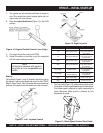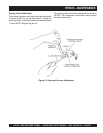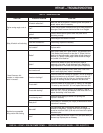
PAGE 20 — HTH44T • RIDE-ON POWER TROWEL — OPERATION AND PARTS MANUAL — REV. #8 (03/27/12)
)
HTH44T— MAINTENANCE
At the front of the book (Page 7) there is a “Daily Pre-Operation
Checklist”. Make copies of this checklist and use it on a daily
basis.
CAUTION!CAUTION!
CAUTION!CAUTION!
CAUTION!
MAINTENANCE SCHEDULE
Change
the
hydraulic oil
and
filter
after the first 100 hours
of use, then change every 250 hours.
Daily (8-10 Hours)
1. Check the fluid levels in the engine and reservoir, fill as
necessary.
Weekly (30-40 Hours)
1. Relube arms, thrust collar and clutch
2. Replace blades if necessary.
3. Check and clean or replace the engine air filter as
necessary.
4. Replace engine oil and filter as necessary, see engine
manual.
Monthly (100-125 Hours)
1. Remove, clean, reinstall and relube the arms and thrust
collar. Adjust the blade arms.
Yearly (500-600 Hours)
1. Check and replace if necessary the arm bushings, and
thrust collar bushings.
2. Check pitch control cables for wear.
3. Adjust blade speed.
4. Replace hydraulic fluid and both hydraulic filters.
Right Spider Speed Adjustment
The right spider’s speed is adjusted by changing the length of
the connecting rod on the pump actuation levers (Figure 17,
Page 21). This rod is basically a turnbuckle. Rotating it in one
direction increases the length and corresponding spider speed.
Rotating it the opposite direction decreases the length and
spider speed. The right spider’s speed should be within 3 rpm
of the left.
A good starting point in the adjustment process is to adjust
the rod such that both spiders begin to rotate at the same time
when the foot pedal is slowly depressed. This will, generally,
get the speeds fairly close. Close enough for use if
instrumentation is unavailable (i.e. on the job site). From this
point on, some form of instrumentation is required to verify
that the right spider speed is within the tolerance specified
above. A strobe or magnetic pickup type speed indicator is
recommended to verify the speeds.
The speeds should be adjusted on a dry concrete floor with
the blades pitched flat. Units with a Kubota turbocharged
engine should be set at 155-160 rpm with the engine at full
speed.
MAINTENANCE PROCEDURES
Checking/Adjusting Blade Speed
Because the two hydraulic drive motors operate independent
of each other, the blade speed between them may vary. If the
unit’s steering is difficult to control, the blade speeds may need
to be checked, or if the spider is spinning noticeably faster or
slower than the other side, the blade speed may need to be
checked. It is also recommended that the blade speed be
checked at least once a year.
Blade speed adjustment is a two-step process. First, the left
spider’s speed should be checked and/or adjusted. Second,
the right spider’s speed should be adjusted to match the left.
Left Spider Speed Adjustment
The left spider’s speed is adjusted by changing the length of
the rod end spacing (Figure 16) at the front of the foot pedal.
Lengthening the spacing increases the blade speed;
shortening the spacing decreases the blade speed.
Figure 16. Blade Speed Control Foot Pedal
See the engine manual supplied with your
machine for appropriate engine maintenance
schedule and troubleshooting guide for
problems.
NOTE
Disconnect spark plug
wires and battery cables
before attempting any
service or maintenance on
the Ride-on Power Trowel.
ALWAYS allow the engine to cool before
servicing. NEVER attempt any maintenance
work on a hot! (muffler, radiator, etc.) trowel.
NOTE
Change
the
hydraulic oil
and
filter
after
the first 100 hours of use, then change
every 250 hours.


















